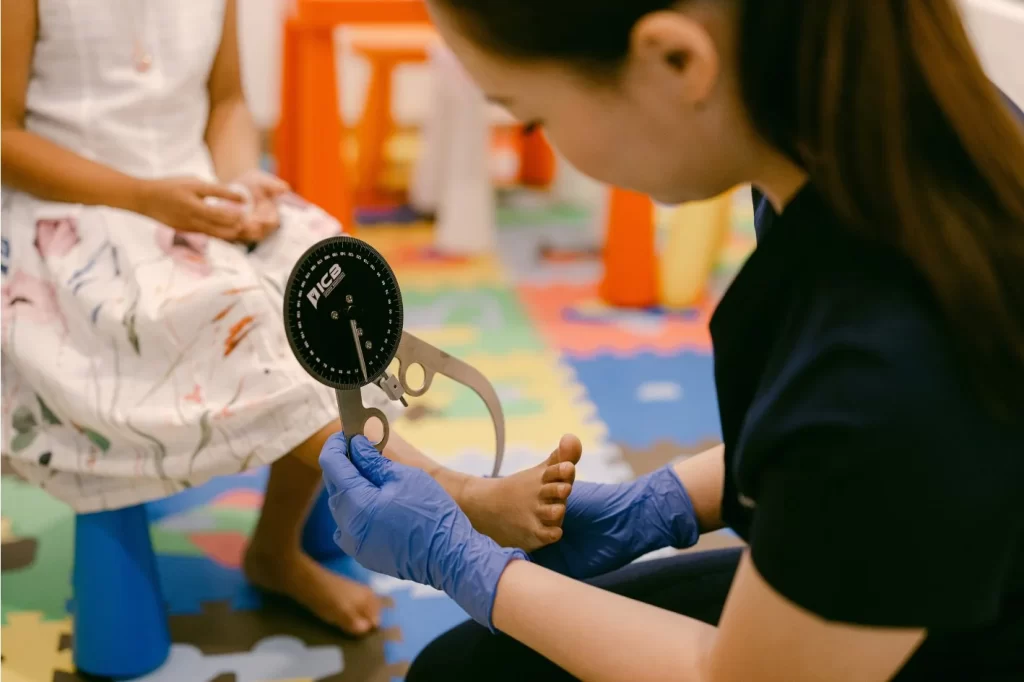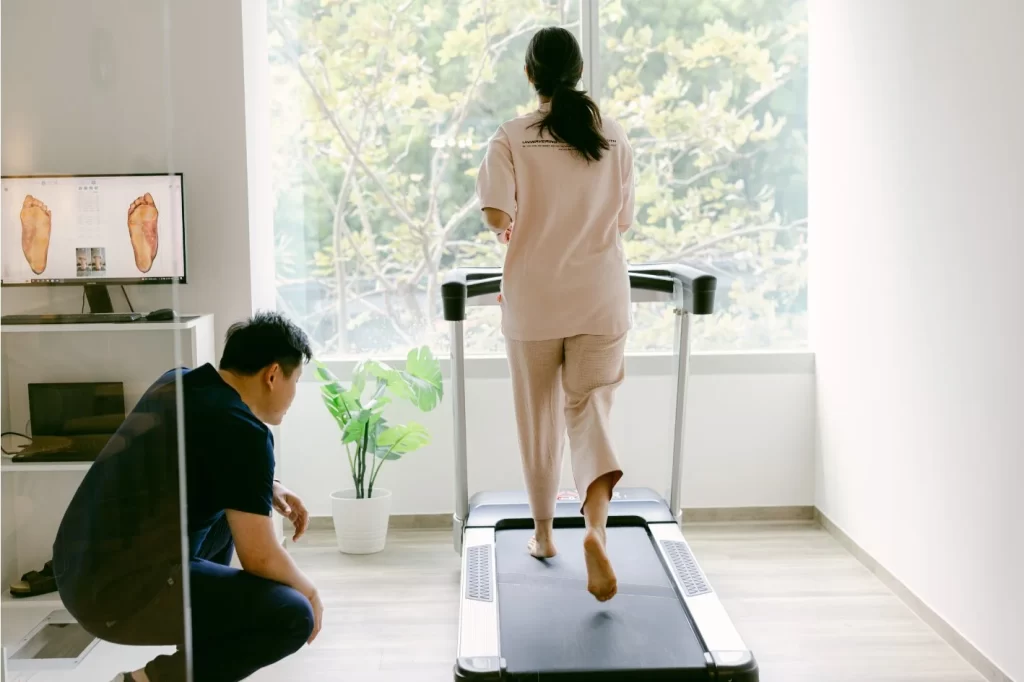Children’s Flat Feet: What Every Parent Should Know
When children take their first steps, every parent watches with excitement (and maybe a little worry). As they grow, you might start to notice their feet looking “flatter” than yours, or their shoes wearing out unevenly. You might also notice that their footprints look odd when you’re at the beach. Sometimes, their grandparents will comment, “Wah, why is my grandchild walking like that? Can you ask somebody to check?” If you’ve ever wondered whether this is normal or something to be concerned about, you’re not alone. These questions are more common than you think, because flat feet in children are a condition that many parents encounter during the growing years, especially in Singapore.
Flat feet in children, or medically called paediatric pes planus, are common — but not always harmless. While some kids outgrow it without problems, others may develop pain, awkward walking patterns, trips and falls easily, or struggle with sports. This is where podiatry for children comes in: to guide parents through what’s normal, what’s not, and when to seek help from a children’s foot specialist.
What Are Children's Flat Feet?
Simply put, flat feet occur when the arch of the foot is lower than usual, causing most of the sole to touch the ground when standing. For toddlers, this is often perfectly normal — their bones, muscles, and ligaments are still developing, and the arch may not be visible yet. Many children “grow into” their arches as they get older. You should typically see an arch forming between the ages 2 to 4.
However, in some cases, the arches remain flat beyond the early years, or they cause discomfort that affects daily life. If your child frequently complains of leg or heel pain, avoids sports, or struggles to keep up with friends at the playground, their feet may require attention

Need Help? See Our Podiatrist Today
How Flat Feet Affect a Child’s Daily Life
For some children, flat feet don’t cause any issues. But for others, the impact can be significant. Imagine your child at recess, eager to join a game of basketball or soccer, but sitting out after just a few minutes because their legs feel tired. Or during a family overseas holiday, your child is lagging behind and asking to rest because their feet hurt. These everyday scenarios show how untreated flat feet can quietly affect a child’s ability to enjoy both school and family activities.
Children may not always use the words “my feet hurt.” Instead, they might say their legs are tired, or you may notice that they avoid sports they used to enjoy. Uneven shoe wear — especially if shoes wear out quickly on one side — can also be a subtle clue. For the little ones, they tend to ask to be carried instead of walking on their own.
Do All Children Outgrow Flat Feet?
The most common question we get asked is whether flat feet in children simply disappear with age. The truth is, some kids do outgrow it naturally as their bones and muscles strengthen, and we call that “developmental flat foot”. But for others, the condition persists into their teenage years and adulthood. The important question is not only whether the feet look flat, but whether the flatness causes pain, fatigue, or difficulties in walking and running.
The last factor that determines the “outgrowing” chances is the type of flat feet that your child has. Broadly, this is categorised into two types: rigid or flexible.
Types of Flat Feet in Children:
- Flexible pes planus – the most common type of paediatric flat feet. In such cases, the joints of the foot are generally hypermobile (overly flexible). A foot arch can be seen when the child stands on their tippy toes. They will also have a noticeable arch when the foot is not in contact with the ground.
- Rigid pes planus – this is rare and typically needs treatment. For a rigid case, you will not see a foot arch regardless of whether your child is walking, standing, or lying down. The foot stays flat throughout, and we would normally suspect an underlying bony fusion (tarsal coalition) or congenital vertical talus deformity that needs to be checked out.

What Causes Children’s Flat Feet?
Most parents tend to look back at their family tree to see who’s responsible. It’s true, sometimes it’s simply a family trait — if mum or dad had flat feet, the chances are higher for the child. But in many other cases, tight calf muscles and Achilles tendons, or unusually flexible joints, play a role. Flat feet may also develop when children spend long hours in shoes without proper support. Not every cause can be easily identified and prevented, so understanding them helps you make informed choices about your child’s footwear and activity.
Is My Child At Risk?
Your child can carry a higher baseline risk if he or she has:
- Family members or parents who are flat-footed
- Generalised hypermobile joints or ligament laxity
- Underlying connective tissue disorders (e.g. Marfan Syndrome, Ehlers-Danlos syndrome)
- Neuromuscular disorders, such as cerebral palsy
- Genetic disorder, such as Down Syndrome
- Tight calves or achilles shortening, particularly those who walk on their tippy toes
- Been wearing poorly supported shoes that are not suitable for the age group
- Weak muscular development due to a lack of activity
What Can Flat Feet Lead To?
Commonly associated painful paediatric foot conditions include:
- Sever’s disease (especially in active kids) or plantar fasciitis — causing heel pain.
- Posterior tibial tendinitis — inflammation of the tendon that causes arch pain.
- Juvenile bunions — a deformity where the big toe deviates outwards.
- Clawed or hammertoes — as a result of the foot compensating to achieve a stable footing.
- Knee or hip pain — due to poor alignment.
- Corns or calluses — as a result of uneven pressure distribution of the foot.
Does My Child Need Treatment?
If your child has a rigid flat foot, treatment is necessary. Otherwise, not always. Many children grow up without problems. But if pain, fatigue, tripping, or posture issues arise, it’s best to see a children’s foot specialist. A children’s podiatrist will first assess how your child walks, runs, and balances. They may check muscle strength, flexibility, and posture. From there, management can range from simple advice on choosing supportive shoes to exercises that strengthen the arches and improve alignment. In some cases, specially made foot braces or insoles are recommended to support the feet, reduce strain, and improve posture.
These measures can’t always “cure” flat feet in the sense of permanently changing foot structure, but they help children move more comfortably, reduce pain, and stay active. Think of it like wearing glasses: they don’t correct vision, but they allow you to see clearly.
Treatment approach
A multi-pronged treatment approach is often necessary to improve the foot posture, starting with:
- Increase physical activity levels or play time to promote muscular development
- Adopt activities such as climbing, beam balancing, and frog jumps, which are great for building overall balance and strength
- Making the routine fun is key because your child is unlikely to follow a strict protocol like personal training
Next, reduce the risk of injuries by supporting each step the child takes:
- Wear supportive shoes that have a proper heel counter and firmer midsoles to help control excessive joint movements, and this will relieve stress on the tendons
- Except for toddlers who have just started walking, a thinner and more flexible sole will help them build spatial awareness and balance better
- Wear custom orthotics that are designed to help reduce pronation and allow the muscles and joints to learn to function in an optimal position
If the child continues to struggle to balance and keep up with their peers:
- Wear a motion-controlling brace, such as a supramalleolar orthosis, which will stabilise their feet when walking or running and improve their balance
- A surgical correction to improve the quality of life may be necessary between the ages of 9 and 14 in extreme cases

Supporting Children at Home
Parents can also play a big role in managing flat feet. Choosing well-fitted, supportive kids’ shoes makes a difference, as does encouraging active play that strengthens the legs and feet, like cycling or swimming. Doing exercises at home — even something as simple as tiptoe walking across the living room — can be made into a fun activity.
But perhaps most importantly, listening to your child matters. If they frequently mention discomfort or avoid activities they used to enjoy, it may be time for a check-up.
Why Early Care Matters
The difference a treatment can make for children with flat feet can be life-changing. Seeing your child, who struggles to play football because of sore feet, not only makes you feel bad, but also makes him sad. Sometimes, with just guidance to get the right shoes or get a pair of insoles, they get to achieve their dreams. These changes for a child can mean the freedom to fully enjoy their childhood.
Parents sometimes feel guilty, wondering if they “missed” the signs earlier. The truth is, flat feet often go unnoticed until they start causing issues. What matters most is recognising the signs now and seeking help when needed. You can also spread the awareness in your parents’ support group so that more children can get the help they need.
When to Seek Professional Advice
If you notice your child frequently tripping, complaining of leg or heel pain, avoiding sports, or wearing out shoes unevenly, it’s a good idea to consult a podiatrist. Remember, not every case of children’s flat feet requires intervention, but professional guidance helps you know whether to watch and wait or to begin treatment.
The earlier potential problems are addressed, the easier it is to keep your child active and confident. Paediatric podiatry focuses on prevention and support, ensuring children can walk, run, and play without limitations.
Frequently Asked Questions
Frequently Asked Questions About Children’s Flat Feet
Can flat feet cause problems later in life?
Do flat feet mean my child cannot play sports?
What are the treatment options for children’s flat feet?
When should I bring my child to see a Podiatrist?
You should consider seeing a paediatric podiatrist if your child complains of foot, leg, or knee pain; struggles to run or do sports; trips frequently; or if you notice unusual shoe wear. It’s also worth seeking advice if flat feet persist beyond childcare age and seem to affect posture or activity. A podiatrist can perform a thorough assessment, explain whether the condition is within the normal range of development, and suggest appropriate management or reassurance.



